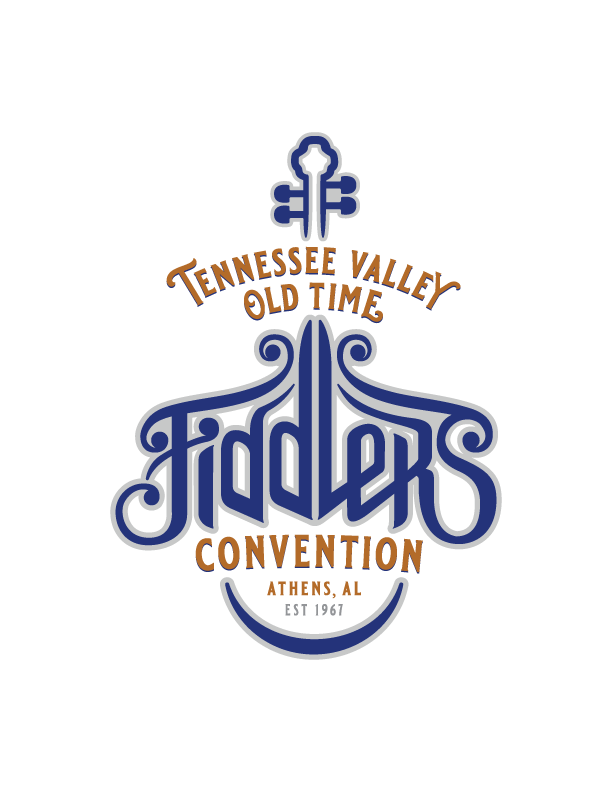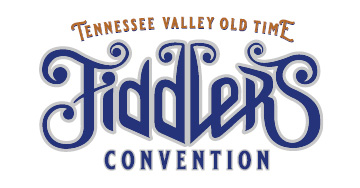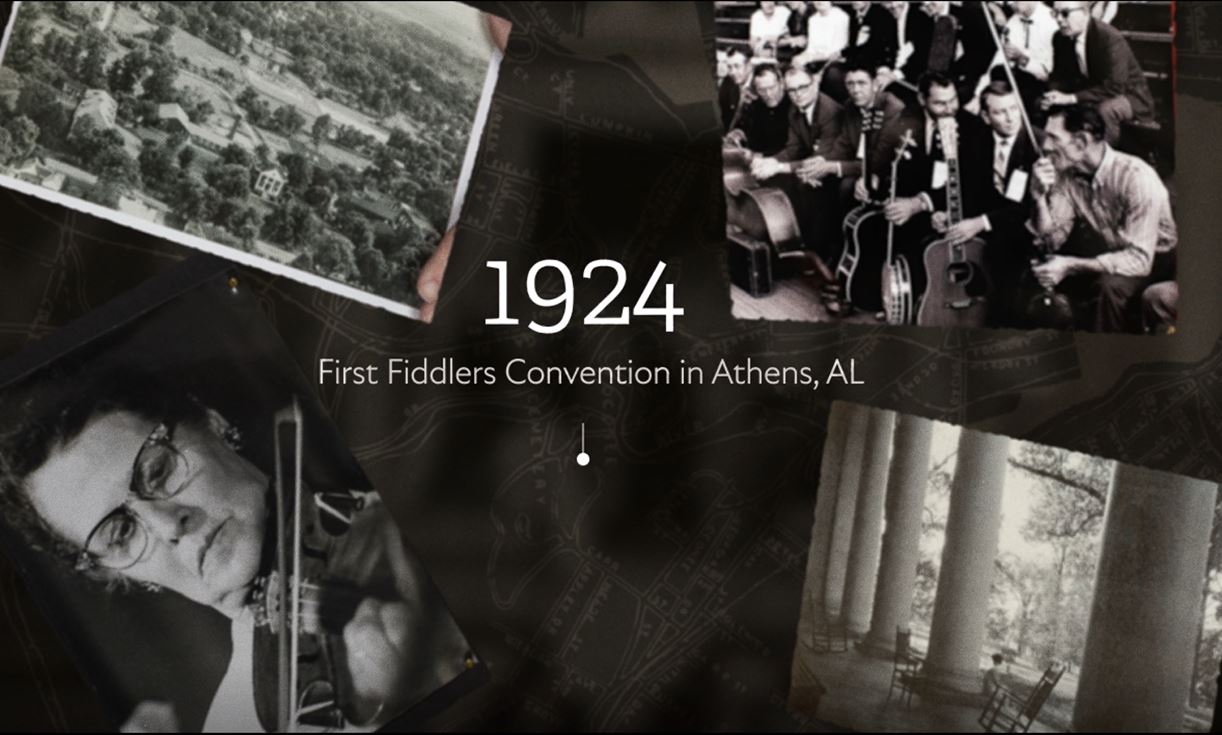Limestone County, Alabama (Athens) has always been a hot bed of traditional old time music. Originally, the county was largely populated by migrant yeomanry from the mountains of the upper south. These migrants were descended from immigrants from the British Isles with a strong tradition of folk fiddle music, therefore, Limestone County, from its frontier days to the present time, has been strongly rooted in traditional old time music.
The Tennessee Valley Old Time Fiddlers Convention, which celebrated its 50th anniversary in 2016, could be considered a renewal of a much older annual Fiddlers Convention, which began at the old Agricultural High School in 1924. The site is now Athens Middle School. This annual event was organized and staged by W.H. Johnson, principal of the school. From all accounts, Johnson loved, respected and understood old time music, and the convention flourished under his direction. It was an important event of its time and drew large crowds from North Alabama and southern Middle Tennessee. It is noteworthy that this convention launched the career of the Delmore Brothers who were natives of Limestone County. The brothers won first prize in their category at the 1930 Athens Fiddlers Convention, and this win motivated them to seek an audition with the Columbia Recording Company. They were accepted and shortly after joined the Grand Ole Opry and became nationally known radio and recording stars. Alton Delmore wrote his hit song “Brown’s Ferry Blues” for presentation at country fiddler’s contests prior to their success in country music.
W.H. Johnson left the Agricultural High School in the mid 30’s and apparently the onset of the great depression coupled with the loss of his dedication caused the event to fold. Fiddle contests and other public presentations of old time music passed into almost total eclipse from the late 30’s into the mid 60’s. Old time fiddlers were discouraged by the lack of interest in their art and many of them retired their instruments to the attics to gather dust. Radios had become more accessible and other types of more sophisticated music were being listened to. It seemed that a lot of people who were raised on old time music were embarrassed to be associated with it. It appeared that old time music was dying.
In the mid 1960’s, it was discovered that a few old time fiddlers in the county had dusted off their instruments and were playing mostly for each other in the privacy of their homes. One of these gathering places was a few miles north of Athens at Sam McCracken’s Elk River home on state highway 99. McCracken, who was born in 1888 and who died in 1972, was a master old time fiddler whose archaic style developed long before the advent of the radio and phonographs and never changed. This courtly old gentleman who had ceased to play his fiddle for more than two decades started to play again and found his skill swiftly returning. It was here at the Friday night fiddling in Mr. Sam’s big living room that Mike Wallis, Ed Christopher, Bob Holland, and Bill Harrison, along with others, began to regularly attend, and the gathering began to grow and interest to rekindle. Inspired by the skill and enthusiasm of the old fiddlers such as Lester Beck, Paisley Hagood, Dennis McGlocklin, Bill Owens, Rob Garris, and especially the rollicking and driving old time style of Mr. Sam, the possibility of organizing a small scale fiddlers contest somewhere in the county began just to see what would happen. Thus, the Tennessee Valley Old Time Fiddlers Convention was born in Sam McCracken’s living room. An abandoned schoolhouse in the Pleasant Point community a few miles west of Athens was mentioned as a possibility to hold this first contest. The community was attempting to raise money to repair the building for a community-meeting place. The community leaders were approached, an agreement was reached, and the plan was finalized. In the late summer of 1967, the first bellwether contest was held at the tiny old Pleasant Point schoolhouse. With only word of mouth promotion, there were more people than seats, and the crowd overflowed into the schoolhouse yard.
Encouraged by the success of the Pleasant Point contest, discussions about a second contest in a larger venue began. At this time the Salem community in West Limestone was raising funds to complete a small hospital left unfinished by the death of the only physician in that area that was an authentic country doctor and a fiddler. The West Limestone High School Gym was chosen, which had a stage and a relatively large seating area. A modest promotional campaign was launched in the local Athens newspaper and as word spread, reporters from area newspapers picked up on the story, with articles appearing in the Huntsville and Decatur newspapers and as far away as Birmingham and Nashville. The West Limestone event was held on February 18th, 1967. The gym was packed with standing room only, and several hundred people had to be turned away.
The success of both the Pleasant Point and the West Limestone fiddler contests led to the conclusion that there was extensive latent interest in old time music represented by an amazing cross section of people in widely divergent social strata. Further, it was decided there was a need to dispel the false image of old time fiddling almost always graphically portrayed as an “overalled-goateed” farmer in a tattered straw hat sitting on a bale of hay holding his fiddle. A lot of farmers who were fiddlers, and good ones too, also found that traditional old time music held the interest of a wide variety of the population – professionals as well as blue-collar workers, shopkeepers and business executives, and even holders of high public office. Burl Ives, the late folk singer, once observed that the most lucrative place to collect folk songs is the city. He said that most people have a rural background and when removed from that scene remember the old sounds more vividly and nostalgically. Thomas Jefferson was a fiddler, as well as an accomplished classical violinist. When he ran across old fiddle tunes he liked, he wrote them down in his notebooks. It has been reported that the old fiddle tune “Grey Eagle,” still heard frequently at fiddler’s conventions, was one of his favorites. Fiddling’ Bob Taylor, who was governor of Tennessee from 1886 to 1890 and again from 1896 to 1898, was a cultured, educated man and a dedicated old time fiddler. He made national headlines by entering fiddle contests while he was holding the governor’s chair. Out of office he wrote an eloquent and moving tribute entitled “To the Fiddler” datelined En Route April 24, 1899 https://archive.org/details/govtaylorslovele00tayl/page/42.
After several discussions, the decision was made that an organization was needed to activate the interest in old time music and to provide the opportunity for old time musicians to be heard and appreciated by large audiences. This organization would also provide an information network to keep musicians and fans involved. In the summer of 1967 the Tennessee Valley Old Time Fiddlers Association (TVOTFA) was formed. The two main objectives of the TVOTFA were to sponsor an annual fiddler’s convention and contests and to publish a newsletter on a regular basis. The overwhelming success of the West Limestone contest proved more space was needed and additional facilities to meet the potential of an annual event.
Bob Holland and Bill Harrison approached the officials of Athens College, then a private institution, and proposed that the college host the annual TVOTFA convention with the net proceeds going to the college scholarship fund. An agreement was reached and planning began.
The anvil shoot kicked off the first annual Tennessee Valley Old Time Fiddlers Convention on Saturday, November 4, 1967 in the big Athens College Gym. The weekend saw torrential rain, and when Saturday night arrived, the temperature had plummeted to 24 degrees. While the bad weather had an adverse effect on attendance, the event was a modest success and netted $52. Contestants and spectators came from four states. Bill Mitchell, then sheriff of Lee County Mississippi (Tupelo), was crowned the first Tennessee Valley Fiddle King and E.A. Cope of Birmingham was the runner-up. Media coverage was encouraging. Radio station WVNA, a CBS affiliate from Tuscumbia, Alabama, was on the scene, and Jack Voorhies, program director of the station, recorded a portion of the convention, which included an introduction, music, and interviews with contestants. Voorhies sent the tape to the CBS network headquarters in New York, and the network aired it on their “Weekend Dimension” show; the following week it was broadcast again on the “Mike Wallace at Large” show. The annual Tennessee Valley Old Time Fiddlers Convention was off and running.





